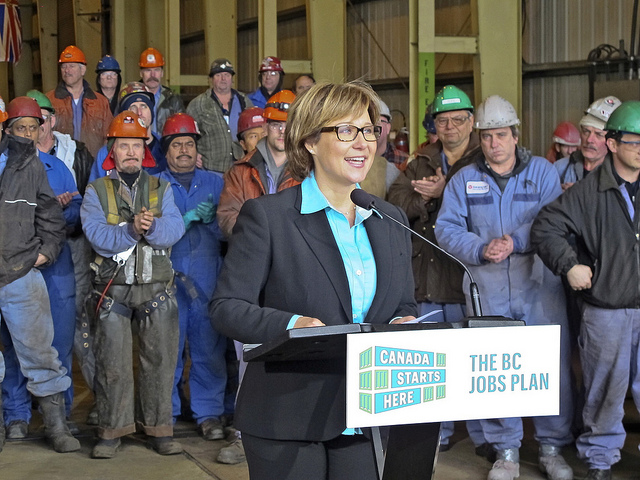The latest B.C. job numbers reveal a picture of persistently high unemployment and stalled job creation. Since January, B.C.’s unemployment rate has been on a roller-coaster ride, down one month and up the next. All in all, there have been very few jobs created in 2013, far fewer than needed to employ our growing working-age population.
In fact, B.C. is a laggard in job creation this year, placing in the bottom three provinces in Canada. Only New Brunswick and Nova Scotia have created fewer jobs than us (they’ve actually seen job losses this year), while all other provinces have managed to achieve higher job growth.
This is a problem that requires governments — both federally and provincially — to take a more active position. Simply standing out of the way and waiting for foreign investors to create jobs is not going to do it; it’ll only mean that we’ll be stuck with persistently high unemployment for a long time, depriving young people of career opportunities, resulting in needless suffering of those who can’t find work, and slowing down our economy for years. We can’t afford to remain complacent.
The BC Jobs Plan isn’t going to do it. That’s because (as we’ve previously argued here), it doesn’t address the key underlying cause of our sluggish job creation — the lack of demand.
The reason why business isn’t investing and hiring more people is that the expectations for sales and profits are low. And that’s because B.C. consumers are spending less, weighed down by record high debt-levels, relatively high unemployment, family incomes that have stagnated for the last four years nationally and in B.C. have actually dropped since 2009, and a weak housing market that’s either heading for a prolonged slowdown or a crash in urban hot spots like Vancouver. None of these factors bode well for household’s new worth and future spending plans. It’s easy to see this creates a vicious circle — customers not spending means businesses don’t expand hiring, family incomes remain low, so customers spend even less.
Exporters are also having a hard time as China is slowing down, Europe is still fighting an economic slump that its own austerity policies brought on, and the U.S. is yet to recover.
To make matters worse, the B.C. government’s own policies, narrowly focused on reducing the deficit, have been working against the job market. Cost-cutting governments don’t buy things and reduce jobs (July marked the third consecutive month of job declines in the public sector for B.C.), so the slowdown continues.
The bottom line is, the economy works better when the money is circulating around, and that happens when more people have jobs and livable incomes. When consumers aren’t spending and businesses aren’t investing, the government must step in. What’s needed is a boost in family incomes that will inject money in the economy.
While provincial government policy can’t fully compensate for the global economic slowdown, and the federal government is better positioned to engage in stimulus spending, provincial governments can certainly cushion the blows. Public investments can directly create jobs and boost incomes, but they can also attract and drive private investments in infrastructure and other areas that will meet community needs.
In fact, the smartest way out of the jobs crisis is to put some of our collective resources to work on serious social and environmental problems like climate change, poverty and the affordability crisis facing many families. This way, we will create jobs in the short term while improving quality of life and setting our province up with the basis for a robust and sustainable economy in the future.
I’m talking about investments in high quality, universal and affordable early child care and education, hiring more teachers to relieve crowded classrooms in our schools and provide the needed supports for students with special needs, and boosting funding to make post-secondary education and skills training accessible to all who need it.
Other ideas for boosting job creation and our economy include: investments in making our homes, schools and hospitals more energy-efficient (which will create jobs in construction, reduce energy consumption and help us meet our climate goals), and a large-scale reforestation program post the pine-beetle devastation to breathe life into many rural communities. Youth-focused initiatives should also be on the table, to deal with the massive underemployment plaguing that cohort.
There’s no shortage of ideas. The stumbling block is that an effective job creation strategy will cost money, and this goes against the B.C. government’s current narrow focus on immediate deficit reduction.
The way to move forward is to acknowledge that without more revenues, our government can’t effectively provide the kind of leadership that’s needed at a time of persistent joblessness. And since our current fiscal challenges are the result of years of tax cuts, we can begin to address them with modest tax increases on those who, to quote Finance Minister de Jong, “have a little more” (see here and here).
While slightly higher deficits may be needed in the short term, B.C.’s in a solid position to run deficits for a few more years. The key is taking some of the idle money, the money that businesses aren’t currently investing and consumers aren’t spending, and putting them to work for the B.C. economy.
–
If you’re interested in looking at the numbers yourself, B.C. stats provides a good summary here and a detailed Excel spreadsheet here. For a detailed explanation of why our joblessness problem is worse than what the official unemployment rate would have you believe, see Jim Stanford’s excellent articles here and here.
Photo: BC Gov Photos/flickr



